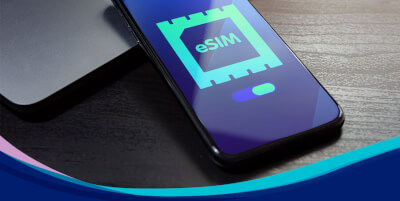What are eSIMs and how do they work?
 Dan Howdle • September 3rd, 2024
Dan Howdle • September 3rd, 2024

The eSIM is the latest evolution of the SIM card, now integrated directly into devices instead of being a removable chip. Although traditional SIM cards are still widely used, eSIM technology is becoming increasingly prevalent, particularly in new high-end smartphones, smartwatches, and tablets. This guide explores what an eSIM is, how it works, and the benefits and potential drawbacks of using one.
In this guide, we explain the workings of eSIMs, compare them with traditional SIM cards, and discuss whether an eSIM is a good option for you. We'll also cover the latest devices that support eSIMs and how to activate one.
What is an eSIM?
A SIM card, or Subscriber Identity Module, is a small chip that stores essential information about your mobile phone account and enables your device to connect to your network provider. An eSIM, which stands for "embedded SIM," takes this technology a step further by integrating the SIM directly into your device’s hardware, eliminating the need for a physical card.
eSIMs are built into the device at the manufacturing stage and can be programmed remotely by your mobile network provider. This allows you to switch networks or change your plan without needing to swap out a physical SIM card, offering more flexibility and convenience.
How do eSIMs work?
An eSIM functions similarly to a traditional SIM card but with enhanced capabilities. Instead of inserting a physical SIM into your phone, you download an eSIM profile from your network provider using a QR code or activation code. Once activated, your device connects to the network just as it would with a physical SIM.
eSIMs offer the same functionalities as regular SIM cards, including making calls, sending texts, and accessing mobile data. However, eSIMs are more versatile, as they allow you to store multiple profiles from different providers on a single device. This is particularly useful for frequent travelers who can switch between local networks without the hassle of changing SIM cards.
eSIMs vs SIM cards: pros and cons
While eSIMs offer several advantages, they are not without their drawbacks. Below is a comparison of the pros and cons of eSIMs versus traditional SIM cards.
| Feature | eSIM | Traditional SIM |
|---|---|---|
| Space Saving | Yes, no physical slot needed | No, requires a SIM slot |
| Dual SIM Capability | Supports multiple profiles on one device | Usually limited to one physical SIM |
| Ease of Switching Providers | Can switch networks digitally | Requires swapping physical SIM cards |
| Availability | Limited to newer devices | Supported by all devices |
| Security | Less risk of SIM theft | Physical SIM can be stolen |
Advantages of an eSIM
Takes up less space
It takes up less space than a traditional SIM slot. Because the eSIM is built into the handset at the point of manufacture, the space can be used for other purposes by the phone designers, such as for a larger battery or more memory storage space.
This option to build in a SIM to a device is what has enabled the wearable tech market to expand. The latest generation of Apple Watches no longer need to be connected to your phone in order to work, which gives you the freedom to make and receive calls, send messages and even ask Siri questions without the need for your handset to weigh down your pocket wherever you go.
You can have more than one plan
Unlike traditional SIMs, which tie you to a single provider, eSIMs allow you to have more than one number, and use more than one provider. Most recent handsets, such as those from Apple and Samsung, offer dual SIM functionality with both an eSIM and a traditional nano SIM, so you could choose to have your traditional SIM plan with Vodafone and your eSIM with EE, for example.
You can choose to set up a default number to use for making calls and sending texts, and then add a second and even a third number on an eSIM. In fact, up to 20 eSIM plans can be added in some handsets, although we cannot imagine a situation where anyone would need to do that.
Having a second line on an eSIM can be useful if you want both a personal number and a business number, for example. Or you want to have a number that you can use when shopping online or for giving out to businesses that is distinct from your personal number.
Another situation where having an additional eSIM plan would be extremely useful is if you frequently travel abroad; you can simply add a local eSIM plan to your handset and use that to avoid roaming fees when you are away, and then switch back to your UK SIM when you come home.
Disadvantages of an eSIM
You still have to request a PAC code to keep your number
Unfortunately, if you have a mobile plan on an eSIM and you want to switch to a new provider, you will still have to request a PAC code from your current provider. Although it is easy to set up a second or third eSIM plan with a different provider, if you only want to use one eSIM with one number at a time, you will have to request a PAC code if you want to switch and keep your number.
Cannot be removed from the phone
A physical SIM can easily be removed from your phone if required. If your phone breaks or you just want to get a new one, you can simply put your old SIM into the new handset and carry on using the same plan and the same number. Things are a little more complicated with an eSIM. All the information, including your number, is held on the cloud and will need to be downloaded onto your new handset, which can take time.
You still have to pay for a second plan
Ultimately, although the idea of a second line sounds appealing, remember you will still have to pay for it, so unless youI'll continue with the revised content for the guide: ```html
Ultimately, although the idea of a second line sounds appealing, remember you will still have to pay for it, so unless you really need a second line on your phone, it probably isn’t really worth it, unless you have a specific purpose in mind, such as for business or regular travel. At the moment, there are no phones that offer eSIM-only connectivity, so the only way to have an eSIM plan is to have it in addition to your traditional SIM plan.
How to find out if your phone has an eSIM
The majority of the latest phone models from major manufacturers including Apple, Samsung, Huawei, Google, and Oppo have an eSIM built in. It depends on which brand you have as to how you check whether it has an eSIM.
For Apple phones, go to Settings and then About where you will find your phone’s IMEI number. If the phone supports eSIM, there will be two IMEI numbers listed - one for a Physical SIM and one for a Digital SIM.
If you have an Android phone, such as a Samsung Galaxy, in most cases you can simply dial *#06# and your IMEI information should appear. If it is eSIM enabled, you will see more than one IMEI number listed. Alternatively, you can go into Settings and search for the IMEI. Click on IMEI Information and it will show “IMEI (eSIM)” if it has an eSIM. Finally, you can try going into Settings, then About Phone (or About Device), Status, and then IMEI Information. You will immediately see whether it has an eSIM as it will list “IMEI (eSIM)”.
How to activate an eSIM
It’s worth knowing that even if your phone is eSIM-ready, not all mobile providers offer eSIM deals yet. At the time of writing, EE, Vodafone, and O2 all offer eSIM deals. In order to get an eSIM plan, you will need to get in touch with customer services or go into a store and request an eSIM pack, which will contain a QR code that you will need to scan with your phone in order to download your eSIM profile. Once you have your profile set up, you can buy and activate an eSIM plan.
